#Design in Honiton
Text
Taylor Signs

At Taylor Signs in Honiton, we specialise in helping businesses and brands elevate their profile and gain recognition. Our services range from large and small format printing to vehicle graphics, signage, exhibition printing, and design works. Our team is dedicated to providing high-quality products and services to the people of Honiton and the entire South West region.
Business hours: Monday - friday: 8.30-5pm
Payment Method: cash, card, bank payment
Address: 1 Alliance Court, Heathpark Industrial Estate, Honiton EX14 1YL
Phone: 01404 47956
Website: https://www.taylorsignssw.com
Business Email: [email protected]
#Printers in Honiton#Honiton Printers#Vehicle Graphics#Sign Makers#Sign makers in honiton#Graphic Design#Design in Honiton#Window Graphics#Floor Graphics#Banner printing#large format printing#small format printing
1 note
·
View note
Text
Wedding Dress A Journey Through Time and Style
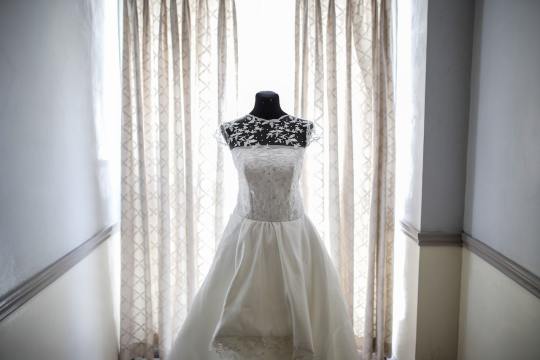
The wedding dress, a symbol of love, commitment, and tradition, has undergone a fascinating evolution throughout history. From ancient civilizations to modern-day weddings, the wedding dress has transformed in style, silhouette, and significance, reflecting changes in culture, fashion, and societal norms. In this article, we'll embark on a journey through time to explore the evolution of the wedding dress, tracing its origins, examining key milestones, and celebrating the diverse styles that have shaped bridal fashion over the centuries.
Ancient Origins: Symbolism and Tradition
The origins of the wedding dress can be traced back to ancient civilizations, where bridal attire played a central role in wedding ceremonies. In ancient Rome, brides wore brightly coloured tunics adorned with intricate embroidery and jewels, symbolizing wealth and fertility. Similarly, in ancient Greece, brides wore flowing robes in vibrant hues, often accented with gold jewelry and floral wreaths to invoke the blessings of the gods.
Medieval Splendor: Luxurious Fabrics and Elaborate Details
During the Middle Ages, wedding dresses became symbols of wealth and status, with nobility and royalty showcasing their affluence through sumptuous fabrics and elaborate designs. Brides wore gowns made of rich silks, velvets, and brocades, embellished with intricate beadwork, embroidery, and lace. These opulent dresses were often adorned with pearls, gemstones, and precious metals, reflecting the extravagance of the era's aristocracy.
Victorian Elegance: White Weddings and Romanticism
The Victorian era saw the rise of the white wedding dress, thanks to Queen Victoria's iconic choice to wear a white gown for her wedding to Prince Albert in 1840. Prior to this, brides wore dresses in a variety of colours, but Queen Victoria's white satin gown, adorned with Honiton lace, set a new standard for bridal fashion. White came to symbolize purity, innocence, and new beginnings, and soon became the traditional colour for wedding dresses.
The Roaring Twenties: Flappers and Fashion
The 1920s ushered in a new era of bridal fashion, influenced by the spirit of the Jazz Age and the rise of the flapper. Wedding dresses became shorter, sleeker, and more daring, reflecting the liberated attitudes of the time. Brides embraced drop-waist silhouettes, beaded embellishments, and art deco details, channeling the glamour and exuberance of the Roaring Twenties. The wedding dress became a symbol of modernity and independence, as women sought to express their individuality through fashion.
Mid-Century Chic: Elegance and Simplicity
In the mid-20th century, wedding dresses took on a more traditional and romantic aesthetic, with designers focusing on timeless elegance and simplicity. The 1950s saw the rise of the full-skirted ball gown, popularized by icons such as Grace Kelly and Audrey Hepburn. Brides embraced delicate lace, flowing chiffon, and feminine details, creating a classic and timeless look that remains popular to this day. The wedding dress became a symbol of romance and nostalgia, evoking the glamour of bygone eras.
Contemporary Trends: Diversity and Individuality
In the 21st century, wedding dress trends have become more diverse and inclusive than ever before, reflecting the changing landscape of bridal fashion. Brides have embraced a wide range of styles, silhouettes, and colours, from bohemian-inspired designs to sleek and modern creations. Designers have responded to this diversity by offering a range of options to suit every bride's taste and personality, whether she's seeking a traditional ball gown or a non-traditional jumpsuit.
Conclusion:
The evolution of the wedding dress is a testament to the enduring power of love, tradition, and fashion. From ancient civilizations to modern-day weddings, the wedding dress has evolved in style, silhouette, and significance, reflecting changes in culture, fashion, and societal norms. Today, brides have more options than ever before when it comes to choosing the perfect gown for their special day, allowing them to express their individuality and embrace their unique style. As bridal fashion continues to evolve, one thing remains constant: the wedding dress will always be a symbol of love, commitment, and timeless beauty.
0 notes
Text
Parasol with Presentation Case 1851
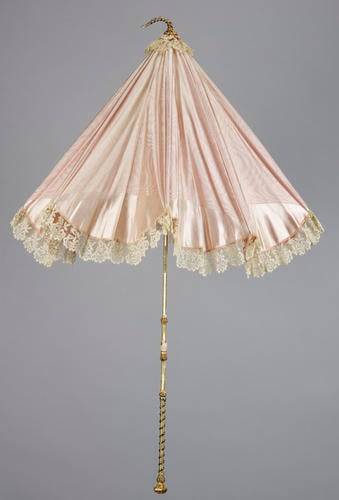


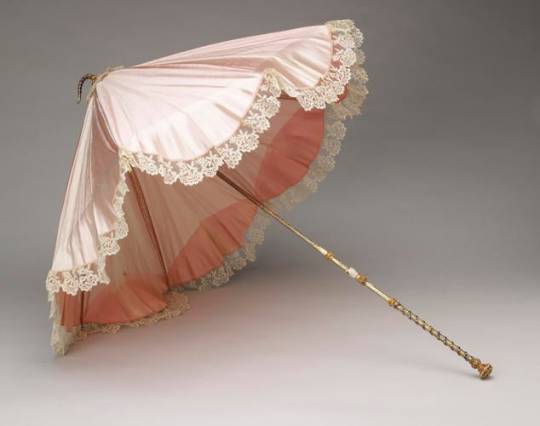
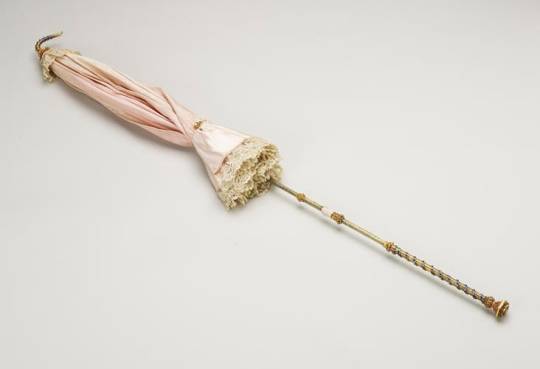

Pink silk parasol trimmed with Honiton lace. The handle is chased and embossed, and entwined with the Garter ribbon terminating in a gem-set pommel with a large citrine inset at the end. The enamelled hand, with a bracelet inscribed ‘I GOVERN’, acts as the opening mechanism. With the original presentation case of dark blue velvet, embossed on the cover with a crowned ‘VA’ monogram.
The rich materials and elaborate design of this grand parasol indicate a specially commissioned piece. However, the ‘Royal Victoria’ - as this model of parasol was named - was advertised in the Illustrated London News in March 1851 by Cheek & Marsh of the Golden Perch, Oxford Street, London.
Stamped: Royal Victoria I A Boss Patentee; engraved: I GOVERN
Text adapted from Victoria & Albert: Art & Love, London, 2010
Provenance
Possibly presented to Queen Victoria at the Great Exhibition opening ceremony, 1 May 1851
1 note
·
View note
Text
The log cabin

At Zook Cabins we want to provide a first-class Cabin buying. Each Log Cabin is expertly built in our climate-controlled manufacturing facility so you can enjoy your Cabin in a timely matter. Walk the woods and country lanes in peace, explore the region's beautiful countryside and visitor attractions, or fish in the nearby lake and enjoy grilled trout for supper on the veranda, before being lulled to sleep by the sound of running water. Whether you are looking for a 2-story Cabin, ranch-style Cabin, or a single-wide Cabin we have a Cabin that will suit your needs. Situated within the Blackdown Hills, and made from weathered pine logs, this unusual holiday home has an open plan living area, a wood burner in a large inglenook fireplace, and a covered veranda ideal for an evening drink and BBQ. The appetizers reminded me of something you. Boasting spectacular waterfront views, the newly refurbished Log Cabin is set to play host to the region once again. The Log Cabins food is consistently subpar but this was exceptionally disappointing - not even close to some of the Big E favorites as advertised Report. Studio Flat Studio flat: 1 Double en-suite, with sofa bed in kitchen diner. Romany Vardo Prices From £50.00 per night. Kennedy Drive and the Stow Lake area to reach the eye-catching Pioneer Log Cabin. Log Cabin Prices £120.00 per night Electricity Included. A destination for the Greater Penrith area, the hotel is steeped in history, home-grown traditions and has been a pillar of the community for nearly 200 years. For a journey back into the past of Golden Gate Park, head for John F. A real rustic retreat! An atmospheric log cabin in a valley on the edge of peaceful woodland, within the grounds of the owner's trout farm, half a mile from the picturesque hamlet of Sheldon, and 7 miles from Honiton. The Log Cabin is your quintessential riverside local. The bedrooms and living accommodation are all spread out across one level and the living area has been designed in an open-plan style, comprising a kitchen, dining area and living area that has its own inglenook fireplace, so that you can enjoy the benefits of this region, even in the colder months. The Log Cabin at MCAS Beaufort is located along a scenic waterfront, this cozy venue is great for intimate events including family reunions, unit functions. Log Cabin Homes welcomes any custom quote without obligation. As its name suggests, it is a log cabin, made from pine and it offers accommodation for up to 4 people. The Log Cabin is used to sleep in and this restores the players energy, passes time, allows the player to hide from enemies, and lets the player save their game. The Log Cabin is situated in the grounds of the owner’s trout farm. The Log Cabin is a medium Constructable used to restore the players energy or hide from enemies.

0 notes
Photo

Ingrid Pollard Three Drops of Blood
Thelma Hulbert Gallery, Honiton, Devon, EX14 1LX
6 August 2022 to 29 October 2022
The exhibition includes photography, print, mixed media, text, found objects and an extensive project archive. It is the culmination of a two-year research project which has seen Pollard travel across Devon. Drawing on her interests in classification, systems of knowledge, leisure, trade and money, Pollard has honed in on botanical gardens, ferns and the unique historical collections of books at the Devon and Exeter Institution. Part of Pollard's research involved exploring the representation of botanicals in local lace making, including the renowned Honiton lace.
Curated by talking on corners.
Look out for the programme of coordinating events, talks and workshops:
20 August: Evening with award-winning folk singer and Paul Hamlyn recipient, Kate Young
24 September: Artist and curator talk: Ingrid Pollard and Dr Ella S. Mills in conversation
29 October: Talk with Liz Wells, Emeritus Professor, School of Art, Design and Architecture, University of Plymouth
October: Creative Writing Workshop with Louisa Adjoa Parker
Thelma Hulbert Gallery
0 notes
Text
It's a new day and age lovelies,as the world evolves so must we,just as Queen Victoria brought out the white wedding dresses into the mainstream consciousness in her day,it is our duty to embrace new trends as they emerge. White wedding dresses have served there purpose,it's time for change especially coming from an African country with soo many prints to play around with .
Just to recap a bit,Our first post on this segment debunked the myth that wearing a white wedding dress became popular because it symbolises purity and suggests a sexual innocence. On the contrary the Colour became norm and prestigious because Queen Victoria chose to wear a dress trimmed with handmade Honiton lace from the small village of Beer, to support the declining lace trade and give the industry a boon. White, she reasoned, was the best way to show off the lace makers' artistry and after news of this charmingly simple frock spread far and wide, reaching across the Atlantic to the colonies, and was syndicated in just about every newspaper column and women's magazine the look took root. Before this women matched down the aisle with different colours
Having put that into perspective, I believe it's time we evolve from the colour "WHITE" while most bride's may feel uncomfortable about the connotations linked with wearing a white wedding dress, it is totally fine to be bold and step out of norm and go with more colour and print. You may however have quite the task when shopping for coloured wedding dresses because most bridal stores are not accustomed to the trend but of course if you're unable to uncover a wedding dress in the colour of your alternative, you always have the solution of getting a dress tailor made for you. You could take along a design you like and ask for something comparable to be created for you.
If thats not convincing enough let's put the financial aspect to it . Wedding gowns can be too pricey just to be worn once and tucked away however brides married in their coloured gowns can Very easily wear the same once again on unique occasion without the fear of screaming "bride" to all and even better if it is a detachable wedding gown, presuming you don't understand what I mean when I say detachable wedding gowns,you my dear have a whole 3 series of posts to catch up on before our next segment.Better run along now,
As we conclude this week's segment of wedding gowns, we would like to acknowledge Rembeka Bridal Shop for winning the award of wedding dress retailers of the year 2022 at the KENYA Wedding Awards last night.Great job.Until next time keep it Dearen

0 notes
Text
Interior Designers Honiton
If you want to make your home designs as per your dreams, here we are there to help you every stage of the way. We Interior Designers Honiton offer a range of services and products that we delivered in agreed timeframes and budgets.
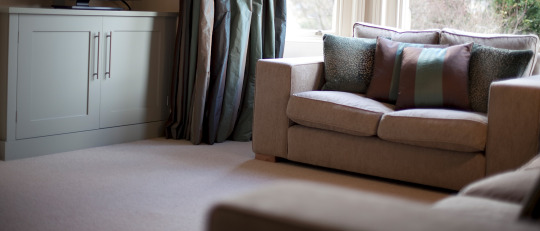
0 notes
Text
A Wedding Quilt from a “Below Stairs” Romance
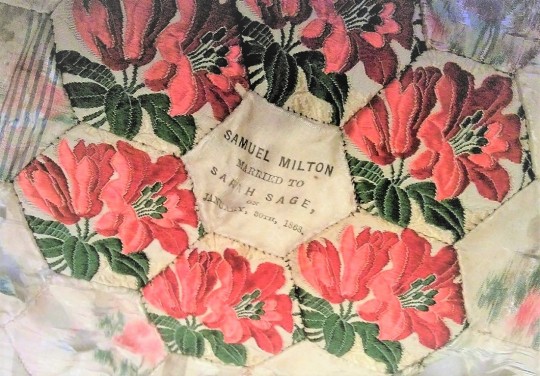
A small white silk hexagon forms the central piece of this patchwork wedding quilt top which was donated to the Collection in 2005. It is printed with the words “SAMUEL MILTON MARRIED TO SARAH SAGE ON JANUARY, 30TH 1868”. Very typical of the printed silk inserts used in greetings cards of the time, it may be from one of their wedding invitations. According to the Accession Register entry, the quilt was bought in the Devon/Cornwall area in 1993.
The quilt top is large and virtually square at 268cm by 261cm. The patches are cut predominantly from multi-coloured silks with some cottons. The concentric rings around the central hexagon consist of flower-like groups joined together.
Having the names of both the bride, groom and a wedding date, it was quite easy to find them in the public records. Sarah Sage, aged 37yrs, married Samuel Milton, 40, on 30th January 1868, at the Parish Church in the small village of Colaton Raleigh, Devon.
The marriage register entry shows that Samuel was the son of John Milton, labourer and Sarah the daughter of Thomas Sage, farmer. Samuel’s occupation is listed as a servant and he is resident in Bovey Tracey. Sarah is listed as a lace maker, resident in Colaton Raleigh.
Looking back into the census returns in 1841 aged 10, Sarah is listed as the eldest of 5 children of Thomas and Mira Sage at Blackberry Farm, Colaton Raleigh.
By 1851, the family had moved to Springles Farm. Her father now the farmer of 10 acres, assisted by his sons, Mark, 16, and Mathew, 14. Sarah, unmarried and aged 20, is listed as a Farmer’s Daughter, and she would have helped her mother on the farm.
By the 1861 census, Sarah appears on the returns for the Divett family at Bystock House, Colaton Raleigh. She is employed there as an under housemaid, with Samuel Milton the coachman – so this is where they presumably met and where their romance began.
The Divett household was large with a total of nine servants including a butler, housekeeper, cook, governess and nurse, plus a gardener living in Bystock Cottage. The Divetts were an important local family. Samuel and Sarah’s employer, Edward Divett (1797-1864) was the Liberal MP for Exeter from 1832-1864. He was a magistrate and Deputy Lieutenant for Devon and the Chairman of the South Australian Banking and Land Company. He had married Ann Ross in 1836 and they had six children.
Edward had inherited Bystock and its large estate on the death of his father in 1819. In 1838, Bystock was described as “one of the prettiest seats in the south-east of Devon” with “a well wooded park and beautiful gardens”. It had beautiful views of the coast from Torbay to Exmouth. 1
Ann Divett died in 1856, and Edward died in 1864, aged 67yrs, at which time Samuel and Sarah would likely have lost their jobs. The marriage register entry indicates that whereas Samuel was living and working as a servant in the Bovey Tracey area, Sarah appeared to have returned to the family home in Colaton Raleigh, turning her hand to lacemaking to provide herself with an income. The village is to the west of Sidmouth, and the well-known lacemaking centre of Honiton is less than ten miles to the north.
We have many pieces of Honiton lace in the Collection. It is characterised by floral motifs (especially roses) with leaves and sprays and…
“...the almost invariable use of ornamental fillings consisting of a network of tiny squares or rectangles. These easily recognised fillings are frequently found in the centres of flowers which remained the favourite motifs for Honiton lace throughout the century. The flowers are generally executed in a simple, rather naïve style...” (Wardle, P137) 2
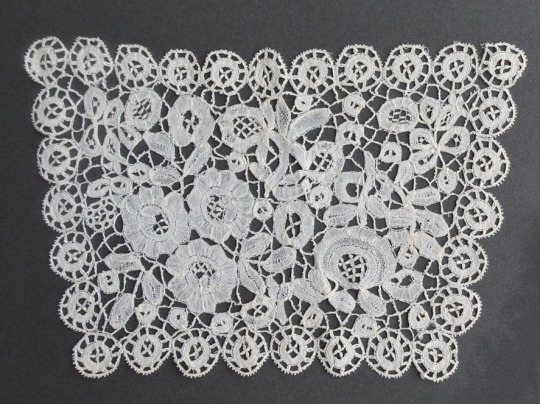
A Honiton lace cuff, showing the floral motifs and fillings
When Queen Victoria married Prince Albert in 1840, she had insisted on using British made goods for the occasion. She commissioned Honiton lace for her wedding dress and veil and her patronage made the lace very fashionable and in demand. The wedding dress can be seen in the Royal Collection here:
https://www.rct.uk/collection/71975/queen-victorias-wedding-dress
Throughout the 1850s, Honiton lace remained popular for wedding and bonnet veils, borders, berthas, collars, cuffs and lappets. However by the 1860s, the quality and design of the lace had started to deteriorate:
“On the one hand there were a small number of very skilled workers, capable of producing the finest types of lace, and these pieces were expressly for royal orders; on the other were the majority of workers who were content to turn out lace of moderate or poor quality for which there was a steady market…
(Wardle P.149)
Unfortunately, we have no examples of the lace that Sarah made to know how skilled she was.
Continuing Sarah and Samuel’s story after their marriage, in 1871 they are living in John Street, St Sidwell, Exeter and Samuel is once again listed as a servant. Then we find the birth of a son, John Thomas Milton in 1872.
In 1881, now living at Little Clifton Street in Exeter, Samuel is an agricultural labourer and John Thomas aged 9, a scholar. By 1891 in Clifton Street, St Sidwell, Exeter, Samuel is a coach builder’s labourer and John Thomas, 19, is a baker.
Sarah died in 1894 aged 64yrs and Samuel two years later in 1896, aged 68; both deaths were registered in the Exeter district. I have been unable to trace their son, John Thomas.
But once again, a small piece of fabric has unlocked a fascinating real-life story behind an item in the Collection.
Jane H
REFERENCES:-
1. Devon Gardens Trust website
https://devongardenstrust.org.uk/gardens/bystock-court
Includes a print of Bystock House, which (judging by the costume) may be about the same time that Sarah and Samuel were working there.
2. Victorian Lace – Patricia Wardle, 1992 (2nd Edition)
4 notes
·
View notes
Text
John Graves Simcoe
John Graves Simcoe (25 February 1752 – 26 October 1806) was a British Army general and the first lieutenant governor of Upper Canada from 1791 until 1796 in southern Ontario and the watersheds of Georgian Bay and Lake Superior. He founded York (now Toronto) and was instrumental in introducing institutions such as courts of law, trial by jury, English common law, and freehold land tenure, and also in the abolition of slavery in Canada.
His long-term goal was the development of Upper Canada (Ontario) as a model community built on aristocratic and conservative principles, designed to demonstrate the superiority of those principles to the republicanism and democracy of the United States. His energetic efforts were only partially successful in establishing a local gentry, a thriving Church of England, and an anti-American coalition with select Indigenous nations. He is seen by many Canadians as a founding figure in Canadian history, especially by those in Southern Ontario.[3] He is commemorated in Toronto with Simcoe Day.
Early Life
Simcoe was the only surviving son of Cornishman John (1710–1759) and Katherine Simcoe (d. 1767). His parents had four children, but he was the only one to live past childhood; Percy drowned in 1764, while Paulet William and John William died as infants. His father was a captain in the Royal Navy who commanded the 60-gun HMS Pembroke during the Siege of Louisbourg (1758), with James Cook as his sailing master. He died of pneumonia on 15 May 1759 on board his ship in the mouth of the Saint Lawrence River a few months prior to the siege of Quebec, and was buried at sea.[4] The family then moved to his mother's parental home in Exeter. His paternal grandparents were William and Mary (née Hutchinson) Simcoe.He was educated at Exeter Grammar School and Eton College. He spent a year at Merton College, Oxford;[5] he was then admitted to Lincoln's Inn, but decided to follow the military career for which his father had intended him. He was initiated into Freemasonry in Union Lodge, Exeter on 2 November 1773
Military career in American Revolutionary War
In 1770, Simcoe entered the British Army as an ensign in the 35th Regiment of Foot, and his unit was dispatched to the Thirteen Colonies. Later, he saw action in the American Revolutionary War during the Siege of Boston. After the siege, in July 1776, he was promoted captain in the 40th Regiment of Foot.[7] He saw action with the grenadier company of the 40th Foot in the New York and New Jersey campaign and the Philadelphia campaign. Simcoe commanded the 40th at the Battle of Brandywine on 11 September 1777, where he was wounded. Legend has it that Simcoe ordered his men at Brandywine not to fire upon three fleeing rebels, among whom was George Washington.[8]
In 1777, Simcoe sought to form a Loyalist regiment of free blacks from Boston but instead was offered the command of the Queen's Rangers formed on Staten Island on 15 October 1777. It was a well-trained light infantry unit comprising 11 companies of 30 men, 1 grenadier, and 1 hussar, and the rest light infantry. The Queen's Rangers saw extensive action during the Philadelphia campaign, including a successful surprise attack (planned and executed by Simcoe) at the Battle of Crooked Billet.
In 1778, Simcoe led an attack on Judge William Hancock's house during a foraging expedition opposed by Patriot militia. The attack killed 10 militiamen in their sleep and wounded five others[citation needed]. William Hancock was also killed, although he was not with the Americans. The attack took place at night and with bayonets. On 28 June of that year, Simcoe and his Queen's Rangers took part in the Battle of Monmouth, in and near Freehold, New Jersey.
On 31 August 1778, Lieut. Col. Simcoe led a massacre of forty Native Americans, allied with the Continental Army, in what is today the Bronx, NY. This place is known as Indian Field[9] in Van Cortlandt Park, Bronx. NY.
On 26 October 1779, Simcoe and 80 men launched an attack on central New Jersey from southern Staten Island known as Simcoe's Raid, from what is known today as the Conference House, resulting in the burning of Patriot supplies inside a Dutch Reformed Church in Finderne, including hay and grain; the release of Loyalist prisoners from the Somerset County Courthouse; and Simcoe's capture by Armand Tuffin de La Rouërie.[10][11][12] Simcoe was released at the end of 1779[13] and rejoined his unit in Virginia. He participated in the Raid on Richmond with Benedict Arnold in January 1781 and was involved in a skirmish near Williamsburg and was at the Siege of Yorktown. He was invalided back to England in December of that year as a Lieutenant-Colonel, having been promoted in March 1782.[14]
Simcoe wrote a book on his experiences with the Queen's Rangers, titled A Journal of the Operations of the Queen's Rangers from the end of the year 1777 to the conclusion of the late American War, which was published in 1787.[15] He served briefly as Inspector General of Recruitment for the British Army, from 1789 until his departure for Upper Canada two years later
Marriage and family
Simcoe convalesced at the Devon home of his godfather, Admiral Samuel Graves. In 1782, Simcoe married Elizabeth Posthuma Gwillim, his godfather's ward. Elizabeth was a wealthy heiress, who acquired a 5,000-acre (2,000 ha) estate at Honiton in Devon and built Wolford Lodge. Wolford was the Simcoe family seat until 1923.[17]
The Simcoes had five daughters before their posting in Canada. Son Francis was born in 1791. Their Canadian-born daughter, Katherine, died in infancy in York. She is buried in the Victoria Square Memorial Park on Portland Avenue, Toronto. Francis returned with his father to England when his tenure expired and joined the army. He was killed in an infantry charge during the Peninsular War in 1812.
Son Henry Addington Simcoe became an English theologian.
Member of Parliament
The Constitutional Act 1791 divided Canada into the Provinces of Upper Canada (Ontario) and Lower Canada (Quebec). The Act established separate governments and legislative assemblies for each province. Lower Canada was the French-speaking eastern portion, which retained the French civil law and protections for the Roman Catholic Church established when Britain took over the area after its defeat of the French in the Seven Years' War. Upper Canada was the western area, newly settled after the American Revolutionary War. The settlers were mostly English speakers, including Loyalists from the Thirteen Colonies, and also the Six Nations of the Iroquois, who had been British allies during the war. The Crown had purchased land from the Mississauga and other First Nations to give the Loyalists land grants in partial compensation for property lost in the United States, and to help them set up new communities and develop this territory.[18]
Simcoe was appointed Lieutenant-Governor on 12 September 1791, and left for Canada with his wife Elizabeth and daughter Sophia, leaving three daughters behind in England with their aunt. They left England in September and arrived in Canada on 11 November. Due to severe weather, the Simcoes spent the winter in Quebec City. Simcoe finally reached Kingston, Upper Canada on 24 June 1792.[17]
In a proclamation on 16 July 1792, he renamed several islands at the mouth of the archipelago at the head of the St. Lawrence river for the victorious Generals at the Battle of the Plains of Abraham (Amherst Island, Gage Island, Wolfe Island, and Howe Island).[19]
Under the Constitutional Act, the provincial government consisted of the Lieutenant-Governor, an appointed Executive Council and Legislative Council, and an elected Legislative Assembly. The first meeting of the nine-member Legislative Council and sixteen-member Legislative Assembly took place at Newark (now Niagara-on-the-Lake) on 17 September 1792.
Following Simcoe's work precipitated by the Chloe Cooley incident, the Assembly passed the first Act Against Slavery in the British Empire in 1793, and the English colonists of Upper Canada took pride in this distinction with respect to the French-Canadian populace of Lower Canada. The Upper Canadians valued their common law legal system, as opposed to the civil law of Quebec, which had chafed them ever since 1763. This was one of the primary reasons for the partition of 1791. Simcoe collaborated extensively with his Attorney-General John White on the file.
The principles of the British Constitution do not admit of that slavery which Christianity condemns. The moment I assume the Government of Upper Canada under no modification will I assent to a law that discriminates by dishonest policy between natives of Africa, America, or Europe.
Slavery was thus ended in Upper Canada long before it was abolished in the British Empire as a whole. By 1810, there were no slaves in Upper Canada, but the Crown did not abolish slavery throughout the Empire until 1834.
Simcoe's first priority was the Northwest Indian War between the United States and the "Western Confederacy" of Native Americans west of the Appalachian Mountains and south of the Great Lakes (the Shawnee, Miami, Wyandot, and other tribes). This conflict had begun in 1785, and was still raging when Simcoe arrived in 1792. Simcoe had hoped to form an Indian buffer state between the two countries, even though he distrusted Joseph Brant, the main Indian leader. Simcoe rejected the section of the Treaty of Paris (1783) which awarded that area to the US, on the grounds that American actions had nullified the treaty.[21] However, the French Revolutionary Wars broke out in 1793. The government in London decided to seek good terms with the United States. Simcoe was instructed to avoid giving the US reason to mistrust Britain but, at the same time, to keep the Natives on both sides of the border friendly to Britain. The Indians asked for British military support, which was initially refused, but in 1794 Britain supplied the Indians with rifles and ammunition.[22]
In February 1794, the governor general, Lord Dorchester, expecting the US to ally with France, said that war was likely to break out between the US and Britain before the year was out. This encouraged the Indians in their war. Dorchester ordered Simcoe to rally the Indians and arm British vessels on the Great Lakes. He also built Fort Miami (present-day Maumee, Ohio) to supply the Indians. Simcoe expelled Americans from a settlement on the southern shore of Lake Erie which had threatened British control of the lake. US President Washington denounced the "irregular and high-handed proceeding of Mr. Simcoe."[23] While Dorchester planned for a defensive war, Simcoe urged London to declare war: "Upper Canada is not to be defended by remaining within the boundary line."[24] Dorchester was officially reprimanded by the Crown for his strong speech against the Americans in 1794.
Simcoe realised that Newark made an unsuitable capital because it was on the Canada–US border and subject to attack. He proposed moving the capital to a more defensible position, in the middle of Upper Canada's southwestern peninsula between Lake Erie and Lake Huron. He named the new location London, and renamed the river there the Thames in anticipation of the change. Dorchester rejected this proposal, but accepted Simcoe's second choice, the present site of Toronto. Simcoe moved the capital there in 1793, and renamed the settlement York after Frederick, Duke of York, King George III's second son. The town was severely underdeveloped at the time of its founding so he brought with him politicians, builders, Nova Scotia timber men, and Englishmen skilled in whipsawing and cutting joists and rafters.[25]
Simcoe began construction of two roads through Upper Canada, for defence and to encourage settlement and trade. Yonge Street (named after British Minister of War Sir George Yonge) ran north–south from York to Lake Simcoe. Soldiers of the Queen's Rangers began cutting the road in August 1793, reaching Holland Landing in 1796. Dundas Street (named for Colonial Secretary Henry Dundas) ran east–west, between York and London.
The Northwest Indian War ended after the United States defeated the Indians at the Battle of Fallen Timbers. They made peace under the Treaty of Greenville. While still at war with France, Britain could not afford to antagonise the US in the Jay Treaty of 1794, and agreed to withdraw north of the Great Lakes, as agreed in the Treaty of Paris (1783). Simcoe evacuated the frontier forts.
Haitian Revolution and later career
In 1794 Simcoe had been appointed Major-General. In July 1796 poor health (gout and neuralgia[26]) forced him to return to Britain. He was unable to return to Upper Canada and resigned his office in 1798.
He served briefly as the commander of British forces during an expedition to capture Saint-Domingue (present-day Haiti). There, in the spring of 1797, he managed to defend the coastal town of Saint-Marc but lost Mirebalais and the Central Plateau to the forces of Toussaint Louverture, who had been the leader of the slave revolt and by that point commander-in-chief of the Republican forces on the island.[27] This campaign signalled the end of the attempt to capture Haiti while the French were preoccupied with their own revolution.[28][29]
Simcoe was appointed colonel of the 81st Foot in 1798, but exchanged the position for the 22nd Foot less than six months later. He was also promoted to Lieutenant-General and was made commander of the Western District. In 1806, he was appointed Commander-in-Chief, India (to succeed Cornwallis, who had died shortly after arriving in India.) Simcoe died in Exeter before assuming the post. Gerard Lake, 1st Viscount Lake, was reappointed to replace Simcoe.
Simcoe was buried in Wolford Chapel on the Simcoe family estate near Honiton, Devon. The Ontario Heritage Foundation acquired title to the chapel in 1982
Death
Death26 Oct 1806 (aged 54) Exeter, City of Exeter, Devon, England
Burial
Wolford Chapel
Honiton, East D
3 notes
·
View notes
Text
RoyalRumormonger’s 10 Most Liked Wedding Gowns
Let me preface this by saying this is based on my own personal style and taste.
10) Mette Marit Tjessem Høiby, Crown Princess of Norway: Ove Harder Finseth
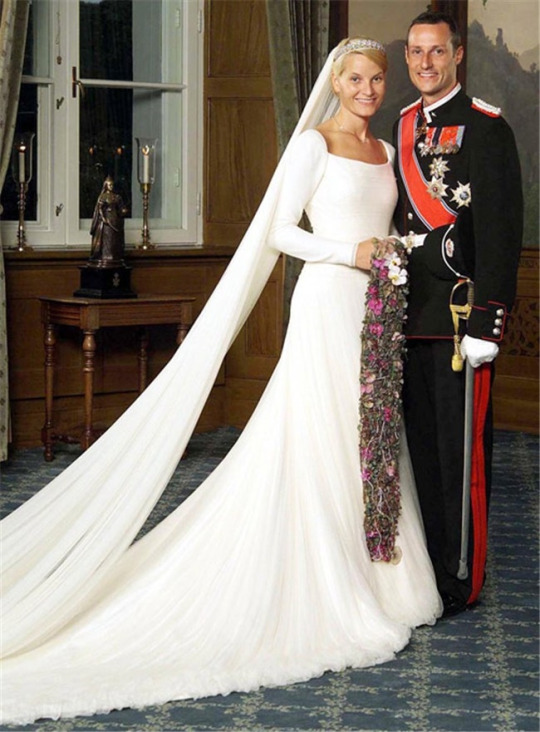

The clean lines and unusual visual texture create such a dreamy cloud-like gown. I like the homage to Queen Maud. This kind of square neckline and silhouette is so flattering on Mette Marit. I oddly like the quirky bouquet that echos the vertical folds of the skirt. The only thing I would change is to add a simple pair of earrings to round out the look.
9) Alessandra de Osmo, Princess of Hanover: Jorge Vázquez
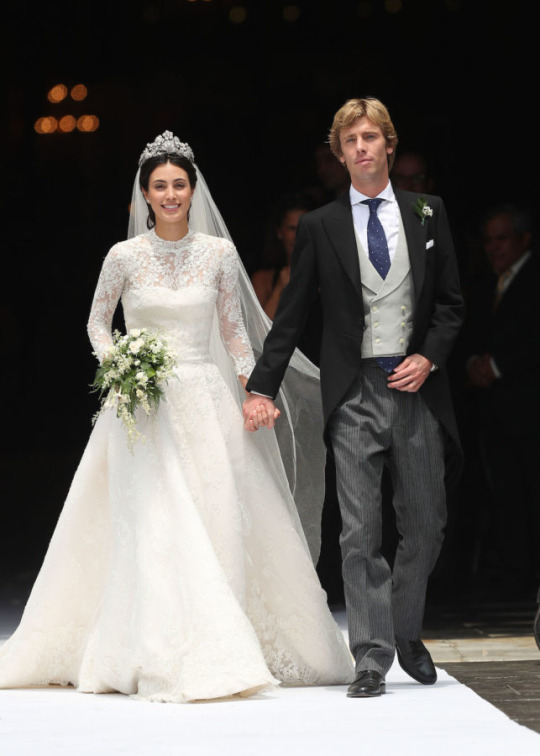
This gown checks all the boxes for a perfect “Royal wedding gown”. Its got lace, its got a high neckline, its got 3/4 length sleeves. What more could you want? The tiara is stunning too. The only thing that keeps it from being placed higher on my list is the mini sweetheart neckline under the lace. It looks like it’s too tight and is a slightly awkward shape.
8) Meghan Markle, the Duchess of Sussex: Clare Waight Keller for Givenchy


This gown is simple, but elegant, and is the kind of look I had hoped she would wear. I love the clean lines of the neckline and silhouette. Is the tailoring kind of messed up? Yes, but it doesn’t bother me that much. The floral veil embroidery and stunning tiara are the main reasons why it is one of my favorite wedding looks.
Catherine Middleton, the Duchess of Cambridge: Sarah Burton for Alexander McQueen

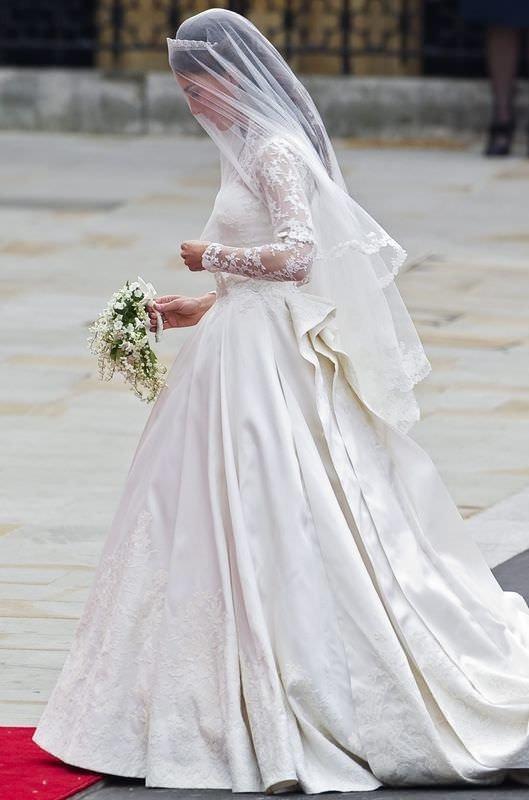
The construction of this gown is hard to beat. I mean lining underneath the train with heavy canvas to prevent it from bunching while the bride is walking? So genius! That’s why I question the need for someone to carry the train while entering the church. Other than that (and the fit around the bust), it is perfect. I love the lace, I love the design of the skirt, I love the bustle. The veil and tiara are beautifully understated. Looking back, I would definitely soften up the look of her makeup, but that’s me being picky.
7) Katharine Worsley, the Duchess of Kent: John Cavanagh
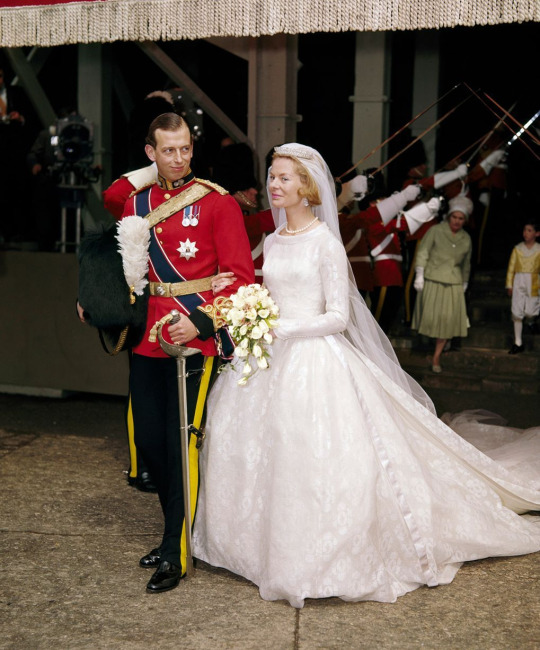
This is such a classic gown, but with a little twist. The fabric has an unusual pearlescent pattern to it. There is something about the combination of her hair, the veil, and this bandeau tiara that I absolutely adore.
6) Queen Margrethe of Denmark: Jørgen Bender
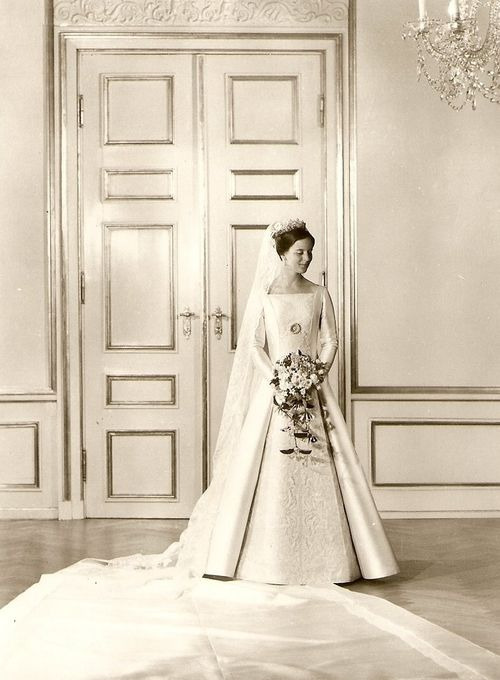
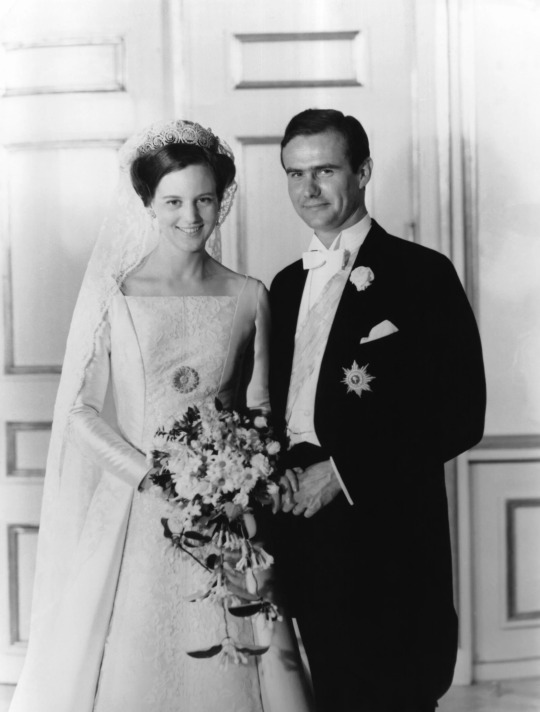
I know some people don’t like this gown, but it’s not as hated as my next pick. The simplicity of this gown is what makes it work. I love the square neckline and the pleated skirt. The heirloom lace panel in the middle adds interest without taking attention away from the rest of the look. I love the daisy brooch pinned to the middle as a tribute to her mother and grandmother. (Once again I must mention my love of the Danish royal family tradition of wearing this tiara and lace veil!)
5) Letizia Ortiz Rocasolano, the Queen of Spain: Manuel Pertegaz
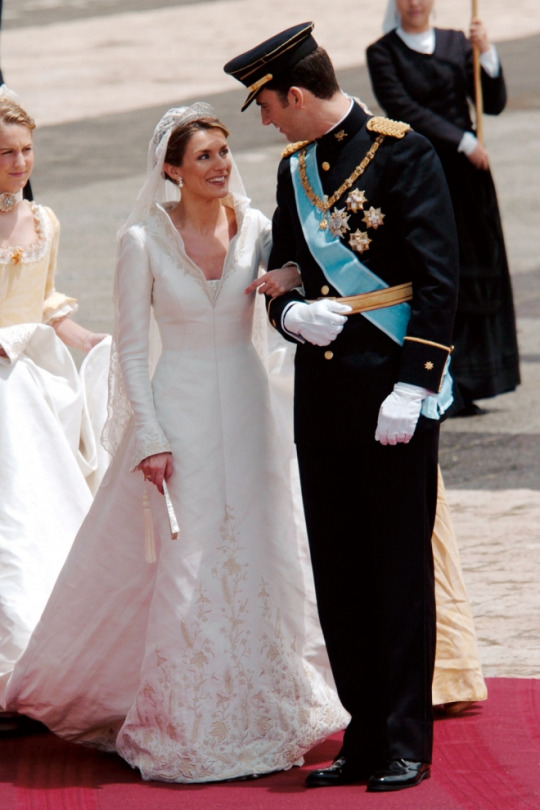
I really don’t understand why so many people dislike the collar of this gown. To me it adds such a regal air to the look. The silhouette is also very flattering. The gown was made of silk fabric that was woven with silver thread to give it a special sheen which is beautiful. I think the silver and gold embroidery is done sparingly, so it doesn’t overwhelm the rest of the look. The veil, tiara, and the matching fan are just the icing on the cake.
4) Beatrice Borromeo: Armani Privé
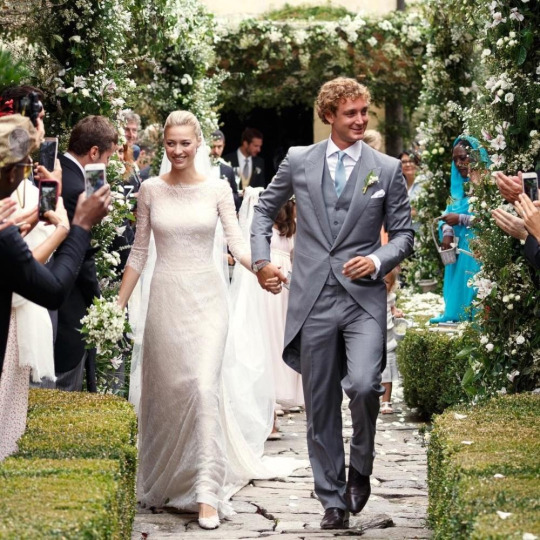
I would include all of her wedding looks, but that would make this already long list even longer. The ones that stand out in my mind are her religious ceremony gown shown above, and her reception gown shown below. The lace gown for the ceremony is just perfect. There is nothing bad I can say about this gown. I love the delicate lace and simple shape. The long train and veil are stunning. Her whole look is one that I would wear for my own wedding.
The reception gown look is what dreams are made of. The angel wing brooches pinned to the back is such a wonderful detail. The long train just tops off the perfection that is this look.
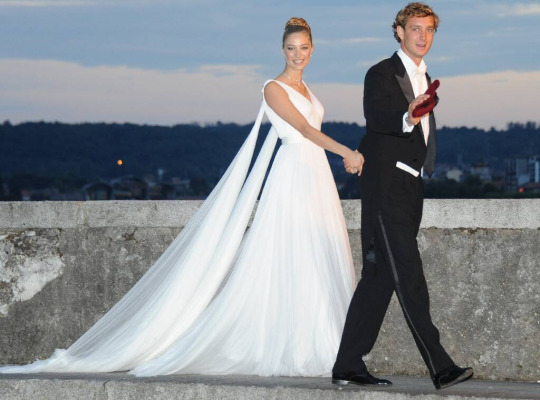
3) Claire Lademacher, Princess of Luxembourg: Elie Saab
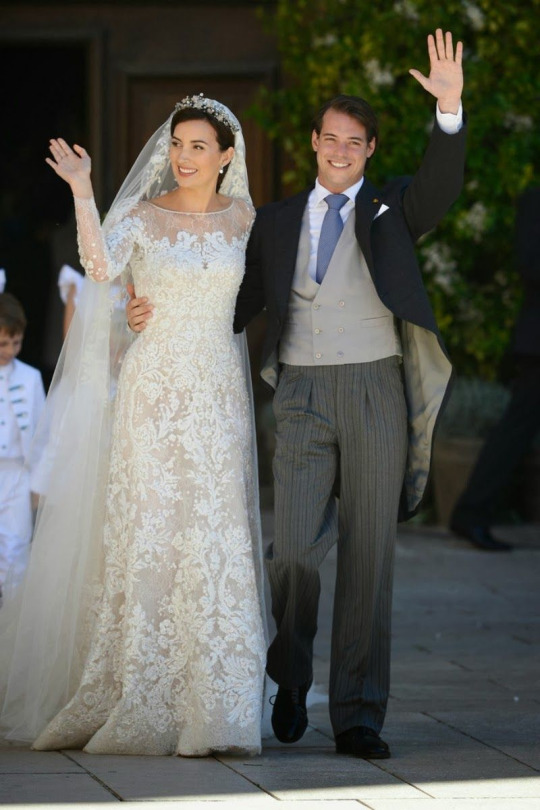
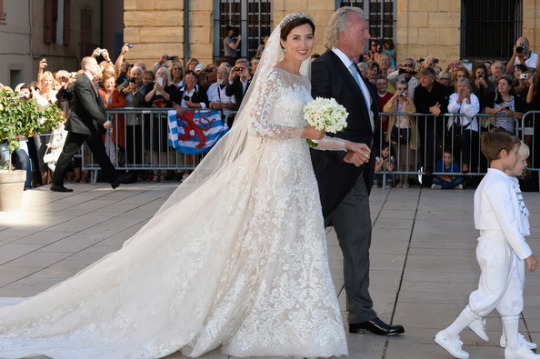
It’s Elie Saab, what else needs to be said? Claire looked stunning. I adore this kind of scroll motif pattern and the silhouette is so flattering. The slight difference in color between the fabric and the embroidery/applique makes the details photograph well. The veil is gorgeous and I especially love her choice of tiara.
Stephanie de Lannoy, Hereditary Grand Duchess of Luxembourg: Elie Saab
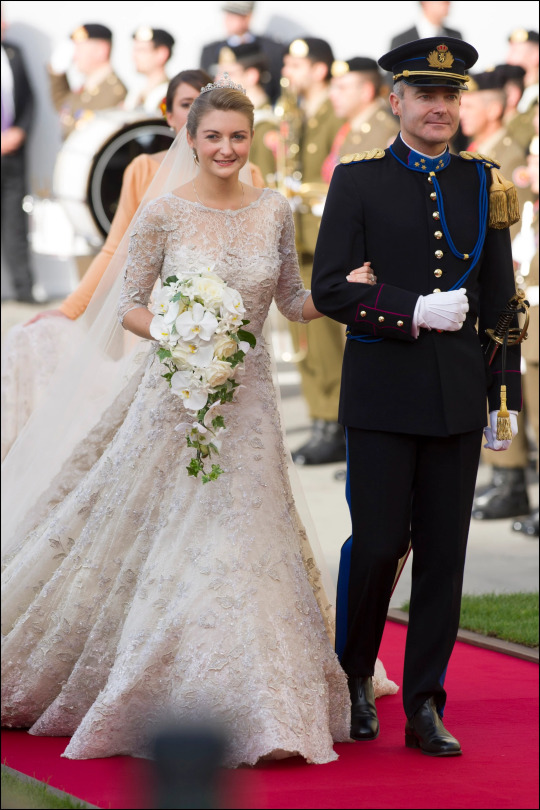
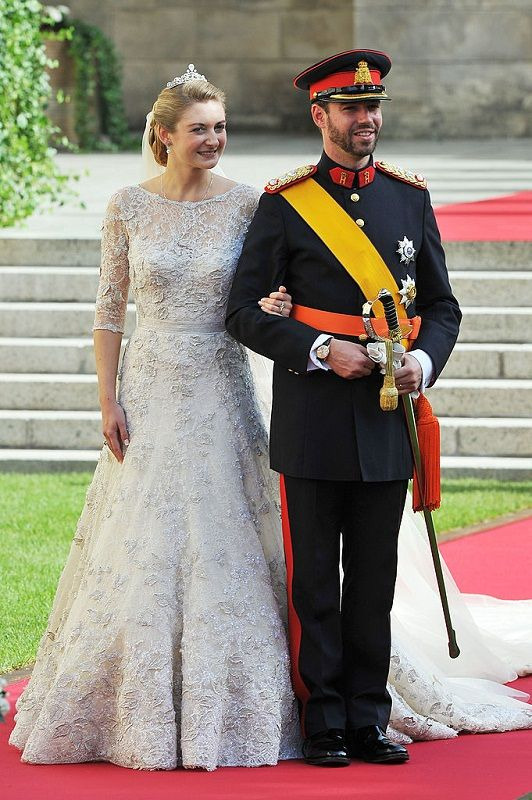

Once again, it’s Elie Saab. The silver leaf appliques and dreamy lace are to die for. Stephanie looked ethereal! The way the train draped down the stairs inside the cathedral made my heart stop. Just stunning! The only thing I can be picky about is the placement of the tiara, but that’s no big deal.
2) Princess Sofia of Greece and Denmark, Queen of Spain: Jean Dessès
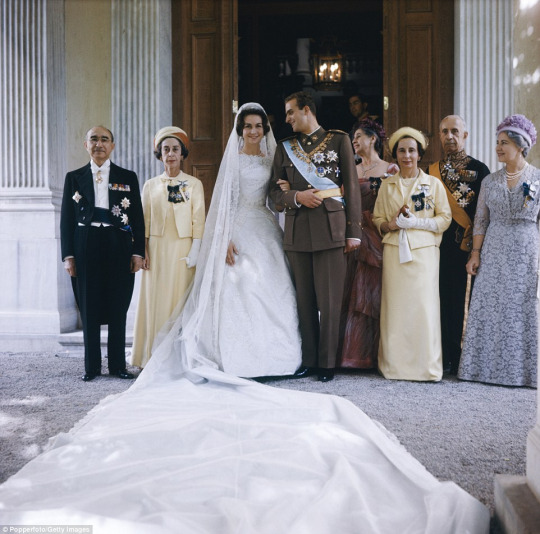

This gown is how you do over the top without looking like a cake topper. I really wish there were better photographs of this gown because it is a work of art. Using silver lamé to back that antique lace is genius! I love the gentle shimmer peaking through. The cape/train adds some interest to the back and the veil with the tiara is stunning.
1) Jane McNeill, Duchess of Buccleuch: ???

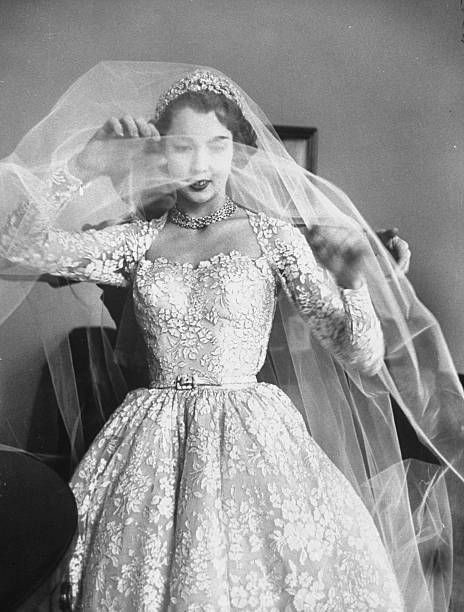
I love lace, what can I say? This is my ultimate wedding gown and I would wear this look in a heartbeat. That silhouette is breathtaking! I adore the way the lace mimics the Mayflower tiara and how the simple veil doesn’t distract from the gown. I also like the thin belt that highlights her waist. 10/10!
***Honorable Mention:
Mary of Teck, Queen of the United Kingdom: Arthur Silk

I have a soft spot for wedding gowns from this era and a soft spot for Queen Mary (the literal icon of this blog!). The materials are to die for! The silk used was patterned with the emblems of shamrock, thistles, and roses. The trimmings were silver thread, Honiton lace, and orange blossoms. Swoon! She also wore her mother’s veil and wore the wedding gift tiara from Queen Victoria tucked behind a spray of orange blossom.
#top 10 most liked wedding gowns#this one was also hard#top 10#top 10 most liked royal wedding gowns
42 notes
·
View notes
Text

For a historic wedding dress, I love Queen Victoria's dress.
From Wikipedia:
Queen Victoria of the United Kingdom married her cousin Prince Albert of Saxe-Coburg and Gotha on 10 February 1840. She chose to wear a white wedding dress, which was considered an unusual choice at a time when colours were more usual,[1] made from heavy silk satin.[2] The Honiton lace used for her wedding dress proved an important boost to Devon lace-making.[3][4] Queen Victoria has been credited with starting the tradition of white weddings and white bridal gowns,[5][6] although she was not the first royal to be married in white.[7]
Design
The lace was designed by William Dyce, head of the then Government School of Design (later known as the Royal College of Art), and mounted on a white satin dress made by Mary Bettans.[8]
The plain, cream-colored satin gown was made from fabric woven in Spitalfields, east London, and trimmed with a deep flounce and trimmings of lace hand-made in Honiton and Beer, in Devon.[8] This demonstrated support for English industry, particularly the cottage industry for lace.[2][8] The handmade lace motifs were appliquéd onto cotton machine-made net.[9] Orange blossoms, a symbol of fertility, also trimmed the dress and made up a wreath, which Victoria wore instead of a tiara over her veil. The veil, which matched the flounce of the dress, was four yards in length and 0.75 yards wide. Victoria's jewelry consisted of a necklace and earrings made of diamonds presented to her by the Sultan of Turkey, and a sapphire cluster brooch given to her by Albert a day earlier. The slippers she wore matched the white color of the dress. The train of the dress, carried by her bridesmaids, measured 18 feet (5.5 m) in length.
Queen Victoria described her choice of dress in her journal thus: "I wore a white satin dress, with a deep flounce of Honiton lace, an imitation of an old design. My jewels were my Turkish diamond necklace & earrings & dear Albert's beautiful sapphire brooch."
30 notes
·
View notes
Text
Royal Christening: The Special Portrait Starring The Royal Baby From Merrimont
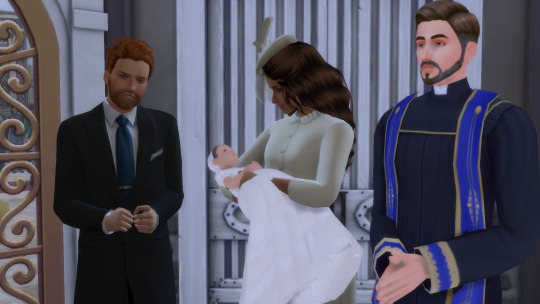
The King and Queen of Merrimont’s third child Prince Alfred was baptized on February 16, at the Chapel Royal of St Jamesons.
The Prince wore a Honiton lace christening gown modeled after one made for King Victor daughter in 1730.
The original was replaced with one, which Prince Alfred wore, designed by Queen Emma's dresser.
Brindleton Bay Palace released a statement later in the day revealing their would be no official portrait taken of the prince and his family.
Many people speculated that this would be the case as the Princess of Farlea and Princess Emilia official christening portrait has never been released due the King and Queen wanting to protect their childrens privacy.
The public reaction to the news of no portrait featuring the prince has been an negative one. The public are starting to speak up about this privacy issue stating they have a right to see the royal family’s children grow as one of their children will be their queen one day and the others will carry out many engagements for the future queen.
This outrage has also caused unpleasant ideals to come to the surface for the royal family, with the public wondering what exactly their paying for since they are not being allowed to see the royal family on many occasions.
#empire royal families#brindleton bay royal family#the sims 4 royalty legacy#the sims 4 royal family#the sims 4 royal challenge#the sims 4 royalty#the sims 4 lets play#the sims 4 monarchy#the sims 4 legacy#the sims 4#ts4 rp#ts4 storytelling#ts4 roleplay#ts4 simblr#ts4 royal family#ts4 royal simblr#ts4 royalty#ts4 royal legacy#ts4 gameplay#ts4#s4 challenge#s4 legacy#s4 royalty#s4 rp#s4 story#s4 gameplay#s4 edit#s4 simblr#royalsims#the sims 4 historical
6 notes
·
View notes
Text
Luxury Interior Designers Dorset, Sidmouth, Honiton & Dorchester.
After ten years running a successful design studio in Bath, Barbara Proctor moved to West Dorset to live six years ago and opened her new design studio and showroom in Dorchester. Having worked on residential and hospitality projects in London, Bath and overseas, Barbara and her team of designers have loved working on exciting new residential and commercial projects in Dorset and Devon. She has recently opened a second showroom in the centre of Sherborne.
Name: Partners In Design
Address: 3 Buttermarket, Poundbury, Dorchester, Dorset DT1 3AZ, United Kingdom
Phone: 01305 457727
Website: http://partners-in-design.co.uk/
1 note
·
View note
Text
Wonderful! Thank you😁❤️❤️❤️❤️❤️
Queen Alexandra
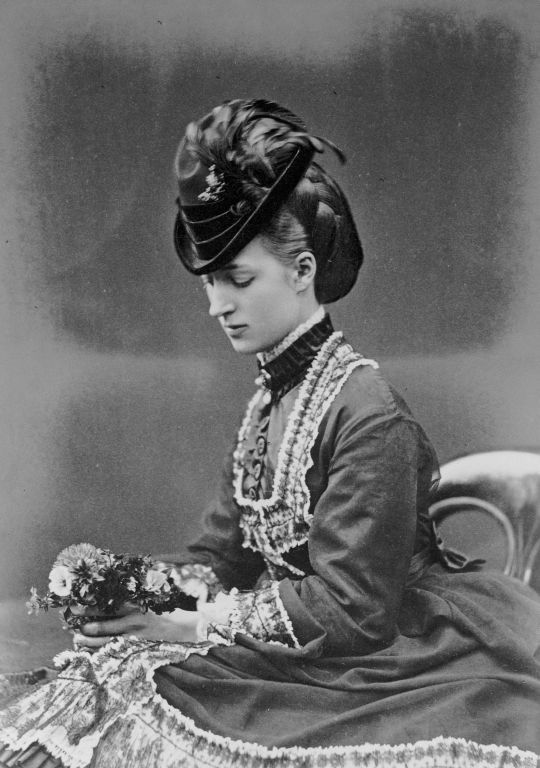
the fashion icon
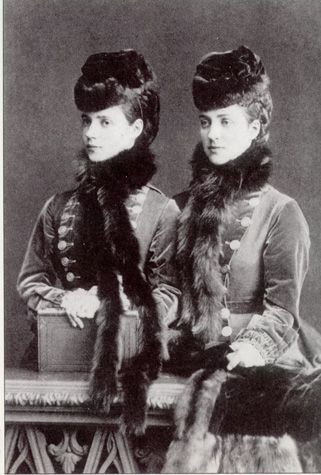
Princess Alexandra of Denmark married Prince Albert Edward, the son of Queen Victoria, at St George’s Chapel, Windsor Castle on March 1863.
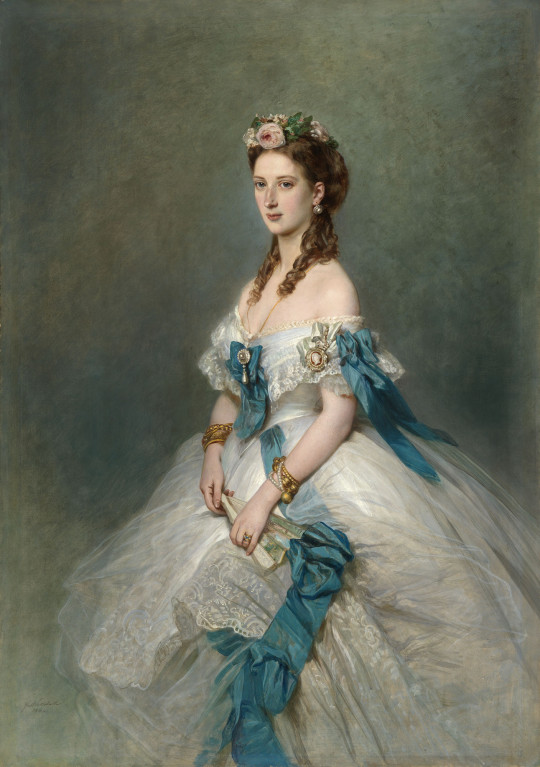
Princess Alexandra’s wedding dress was created by Charles Worth, an English fashion designer working in France, who dominated Parisian fashion at the end of nineteenth century.
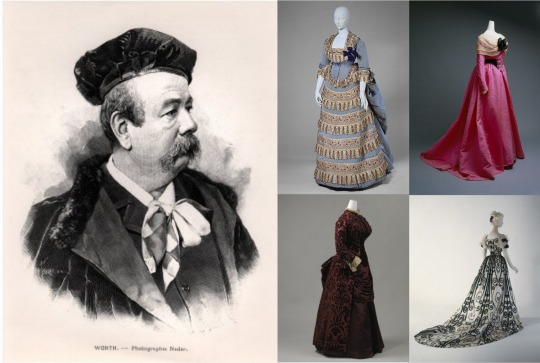
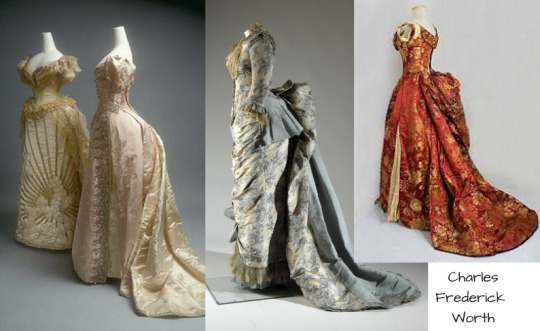
Following the tradition started by Queen Victoria, Princess Alexandra’s ivory gown, with a separate bodice top and full skirt, was made of English silk with a Honiton lace overlay featuring elaborate embroidered symbols of an English rose, an Irish shamrock and a Scottish thistle.

The silver moiré train was 21 feet in length and the gown was further embellished with orange blossoms and myrtle garlands and she wore a veil of Honiton lace with a wreath of even more orange blossoms and myrtle.
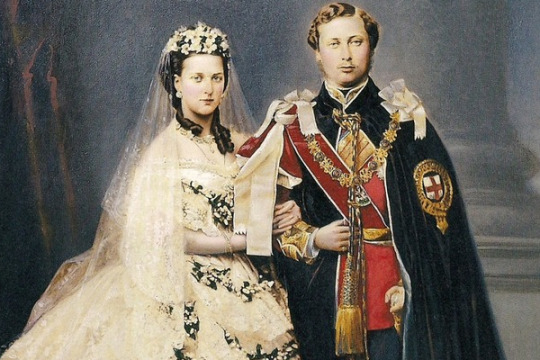
Her bridal bouquet was made of white rosebuds, lilies of the valley, rare orchids, orange blossoms and of course the traditional sprigs of myrtle said to have been grown from a planting taken from Queen Victoria’s wedding bouquet 23 years earlier.
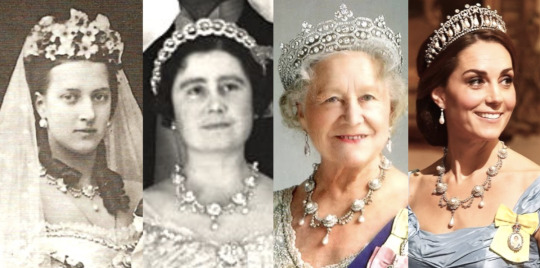
Prince Albert Edward gave her a wedding present of a pearl necklace, earrings and brooch which she wore along with an opal and diamond bracelet that was a gift from Queen Victoria.
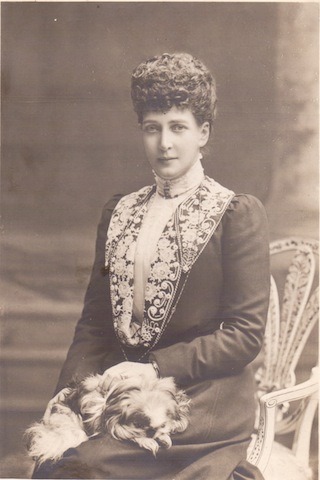
Taking on her new role as Princess of Wales, Alexandra was always acutely aware of her royal duty to dress appropriately for official functions and whenever she was seen in public she was always elegantly dressed in fashions that flattered her body type that would made with the finest fabrics.
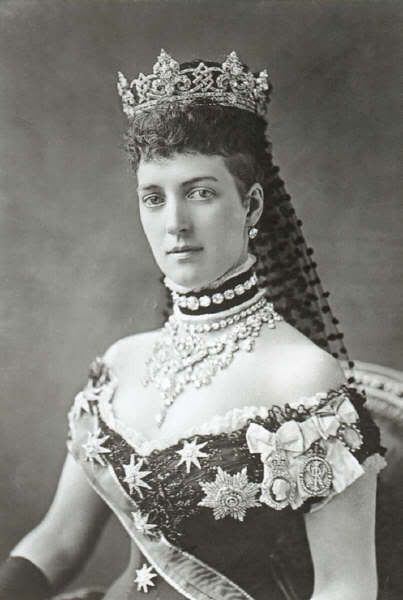
Princess Alexandra was also very creative in adapting her style of clothing to mask several physical impediments. It was said that she had a scar on her neck, possibly from surgery when she was a child, and she took to wearing day dresses with high collars and in the evening she wore multiple layers of pearls or diamond necklaces that would cover her neck, these were known as collier de chein meaning collar necklace.
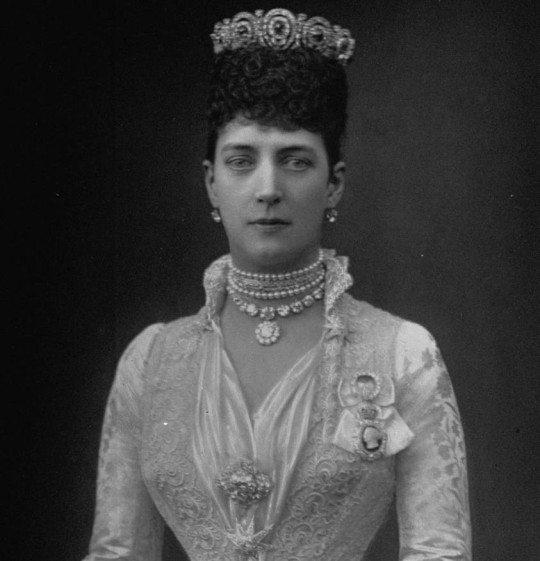
This style of jewelry became very popular with society ladies and a fashion trend was soon started.
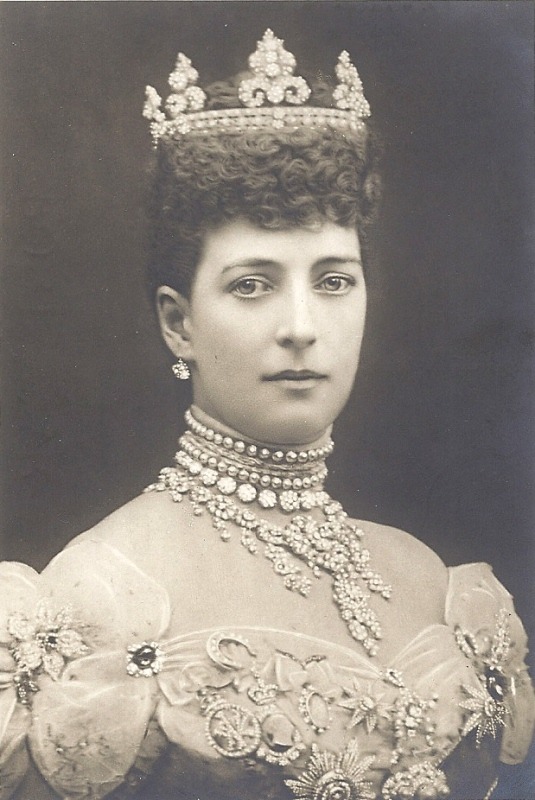
She has also developed a curvature of the spine which was a complication from rheumatic fever that she contracted in 1867.
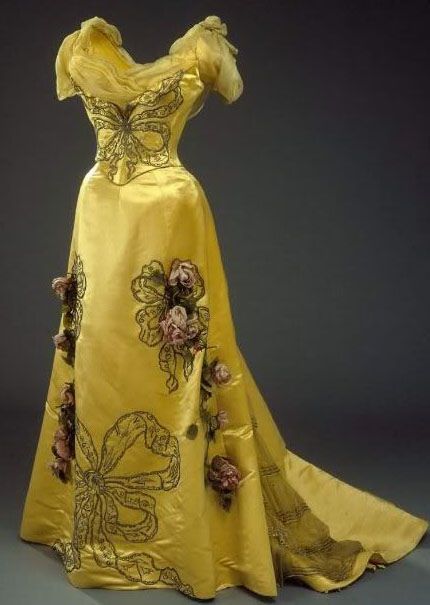
As a result, she walked with a distinct limp for several years and very cleverly adapted her clothing to distract from the physical disability thereby minimizing attention to the problem, or so she thought! The public noticed anyway, calling it the “Alexandra Limp”, and in a strange way it caused another fashion trend.

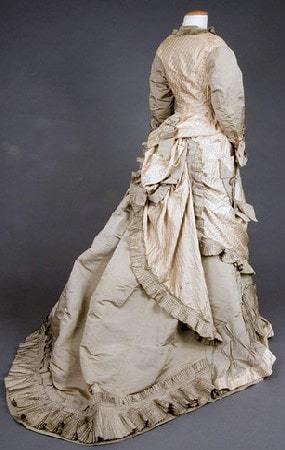
Ladies so admired everything about Princess Alexandra that they were soon emulating the limp by wearing special pairs of shoes in different heel heights or walking with canes. The strange trend did not last long because women fashions were soon changing from dresses with full skirts to more tapered ones causing women to walk with smaller steps and thus eliminating the “need” to limp.

In 1901, Queen Victoria died and Prince Albert Edward became King Edward VII. As Queen Alexandra prepared for the coronation she knew she wanted a very special gown and she called upon her friend, Lady Curzon, to help her. The Coronation Day was set for June when the weather in London would be hot and since the Queen would already be wearing a heavy velvet robe as part of her coronation regalia the material for the dress was made of lightweight net with metallic embroidery. Lady Curzon oversaw the making of the beautiful material which was created in India and the fabric was embroidered with the symbols of England (rose), Ireland (shamrock) and Scotland (thistle) that would represent the countries that King Edward would rule.
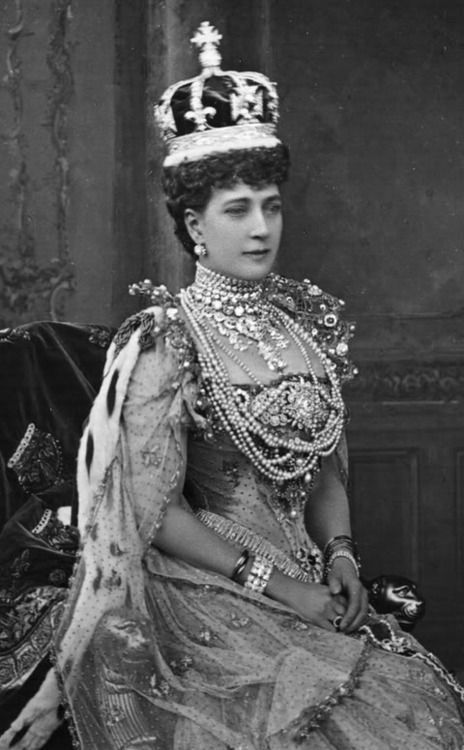
Part of Queen Alexandra’s coronation regalia included a Queen Consort crown that was especially made for her to wear. In 1849, the East India Company had acquired the large 186 carat diamond, known as the Kohinoor Diamond, which was given to Queen Victoria. The Kohinoor diamond was said to be cursed and if any male wore it he would surely lose the throne. Queen Victoria, being female, did not fear the curse and the Kohinoor diamond was cut into a smaller 105 carat diamond which Queen Victoria wore set in a brooch. After the death of Queen Victoria, the Kohinoor Diamond was set into the Queen Consort’s crown instead of King’s crown to avoid the possibility of the validity of the curse. Queen Alexandra’s crown had a platinum frame designed as circlet accented with four large crosses (the center cross was set with the Kohinoor Diamond and the other crosses set with “smaller” diamonds) and four large fluer-de-lis for a base. Four arches set with three rows of diamonds each gently curved to join together and topped with a diamond encrusted orb and cross at the center., approximately 3688 diamonds were used. An inner lining of purple velvet was used under the arches and ermine lined the base so that it would set comfortably on the Queen’s head.
The custom continued afterwards with the Kohinoor Diamond always worn in the Queen Consort’s crown, this was done for Queen Mary at the coronation of George V and Queen Elizabeth at the coronation of George VI but for their daughter’s coronation, Queen Elizabeth II wore the St. Edward’s Crown that has been used to crown every sovereign since 1661.

To complete her coronation ensemble, Queen Alexandra wore Queen Victoria’s diamond bracelet and earrings. Then she layered even more jewels across the front her coronation gown and they were stitched onto the fabric. At her waist she wore the Dagmar necklace (a reminder of her Danish heritage) as a stomacher and several diamond earrings were added to the necklace as pendants.
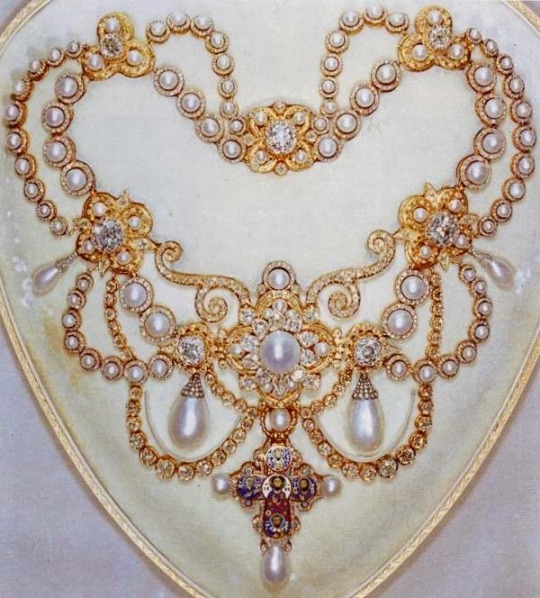
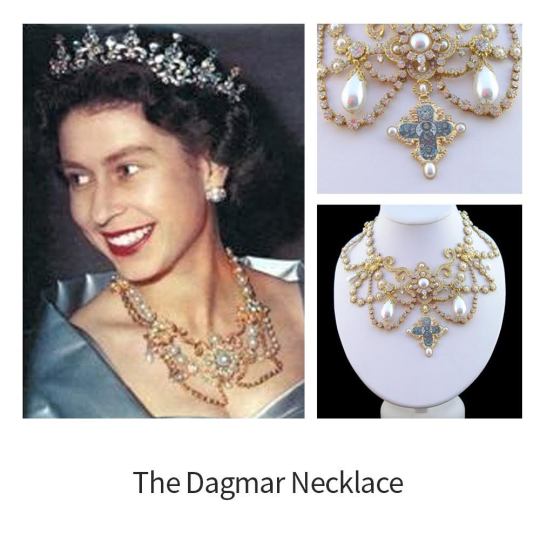
She also wore a set of Queen Victoria’s diamond bow brooches pinned down the front of the gown with additional emerald earrings suspended from the bows as pendants. Around her neck Queen Alexandra wore Queen Victoria’s large diamond necklace and her customary strands of several pearl necklaces.
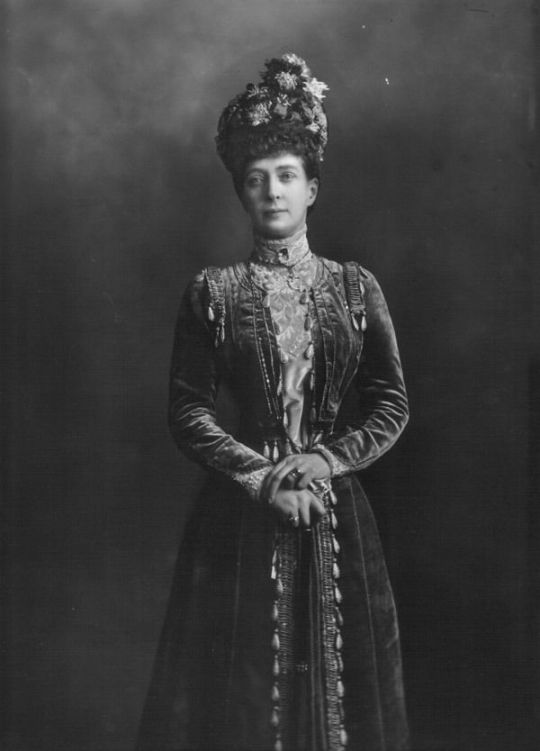
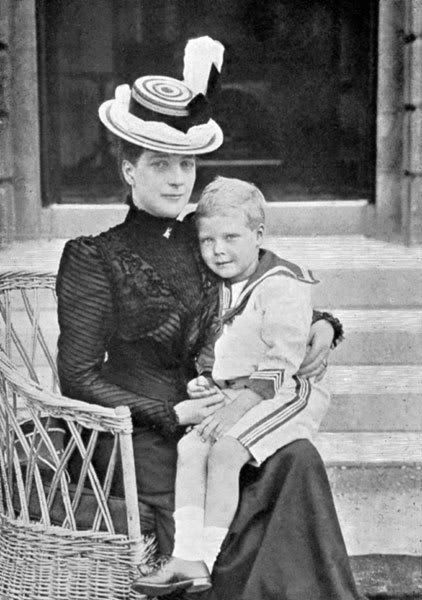
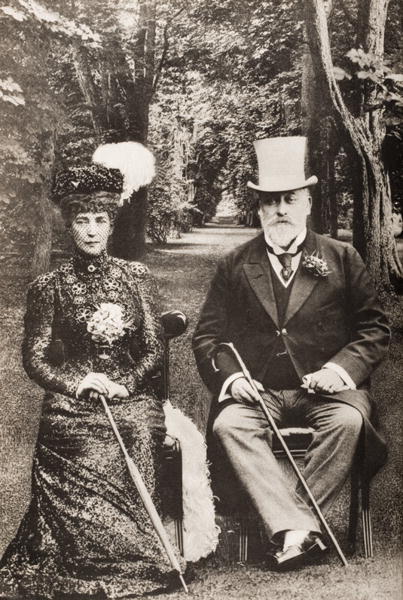
During the reign of King Edward and Queen Alexandra, which became known as the Edwardian Age (1901-1910),
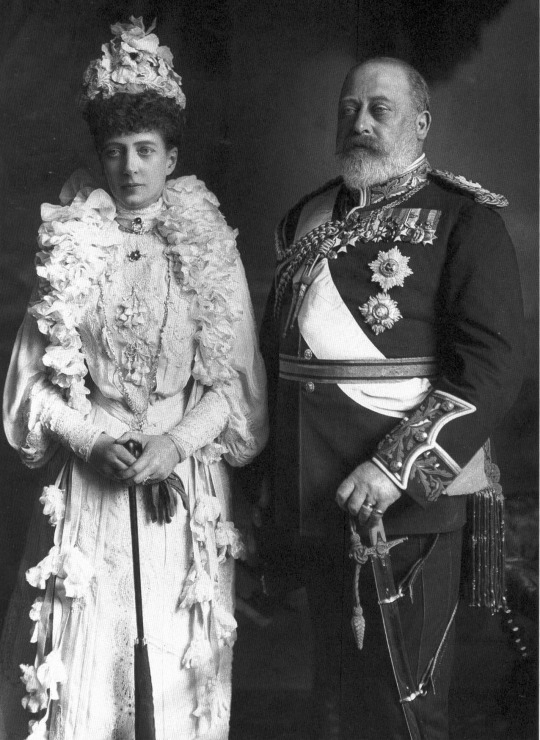
women fashions changed from dresses with full skirts worn with several layers of undergarments to dresses with tapered skirts, tight laced corsets and bustled trains accented with layers of lace and beaded appliques.
48 notes
·
View notes
Text
Bobbin Lace Pictures
I was sorting through the pictures I have of lace, looking for inspiration for tambour designs, I found a bunch of photographs of bobbin lace I have made, as well as the bobbins and pillows I fashioned. Here’s a few of these pictures.
Some flowers I did in Duchesse:
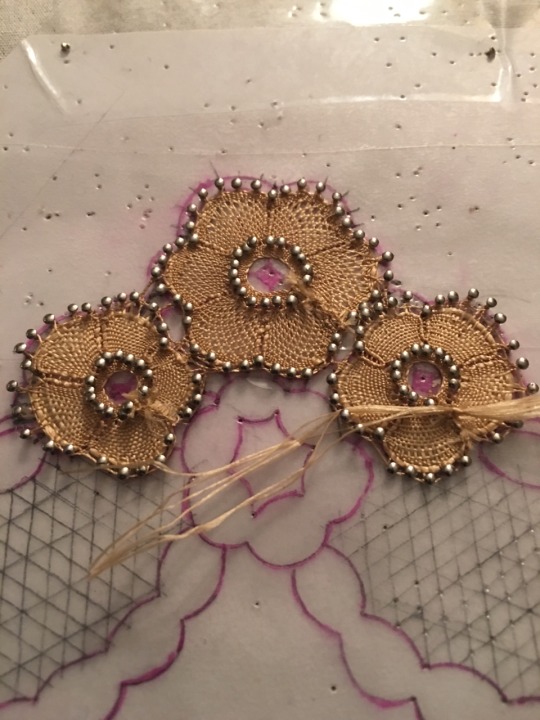
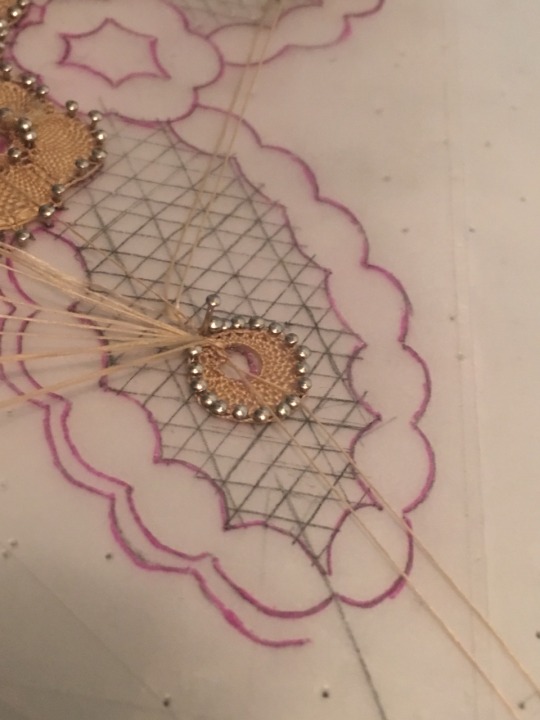
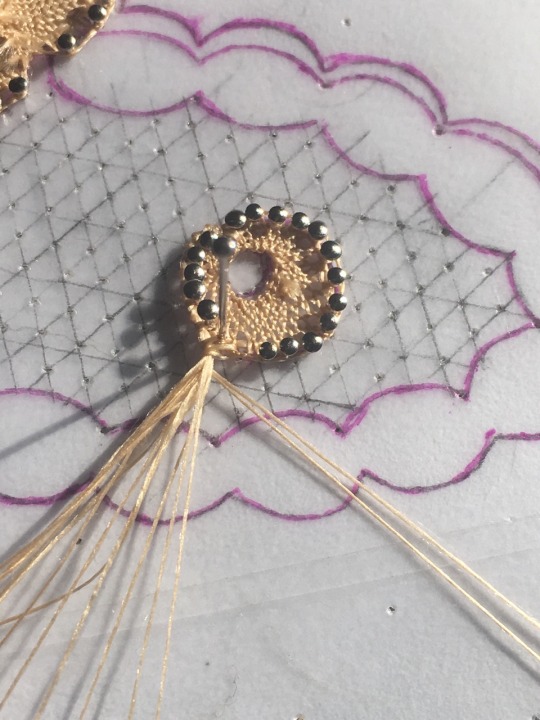
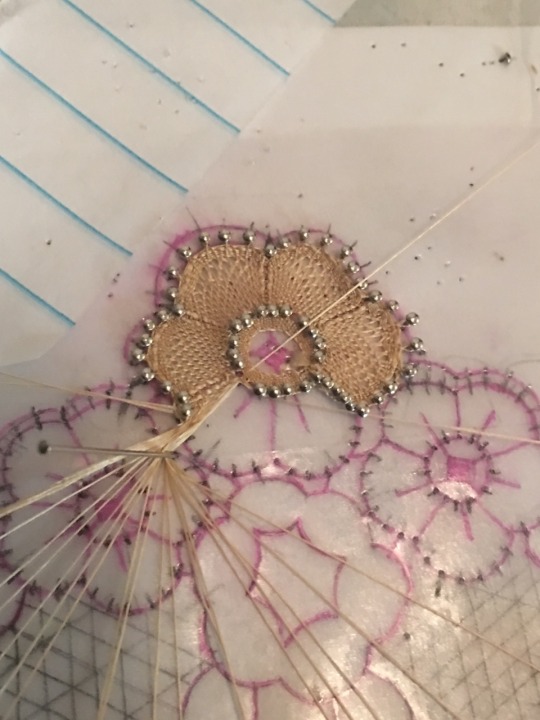
A leaf in raised Honiton:
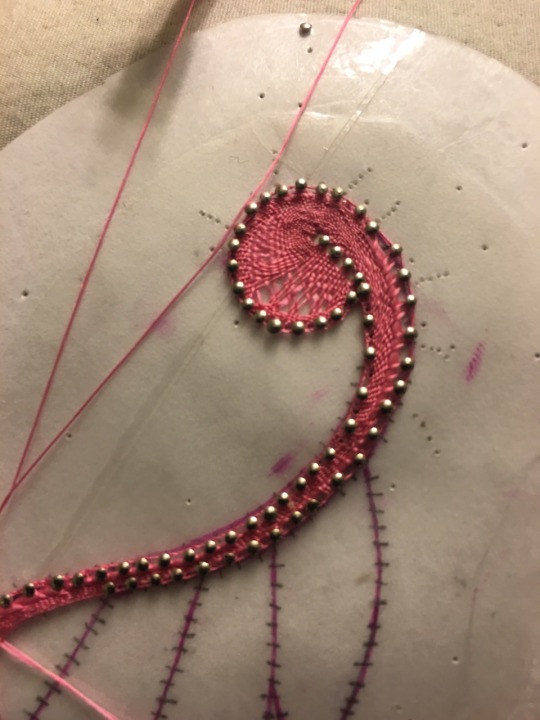

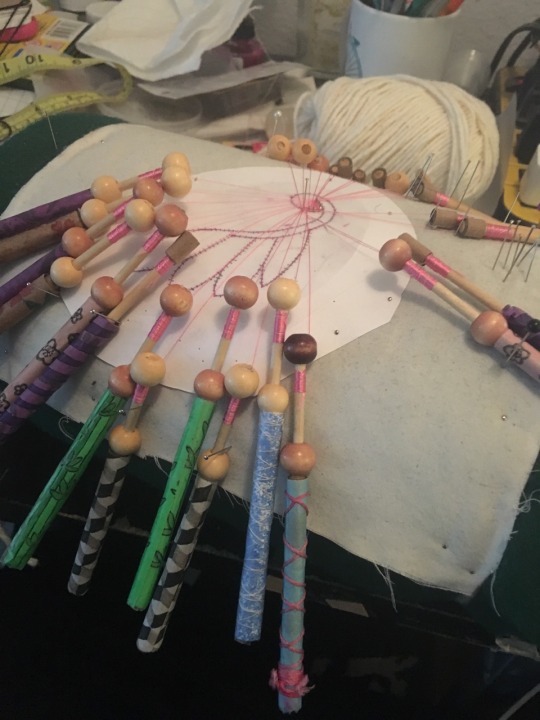

A simple little scroll in Duchesse, also the round pillow I made and the bobbins I made:
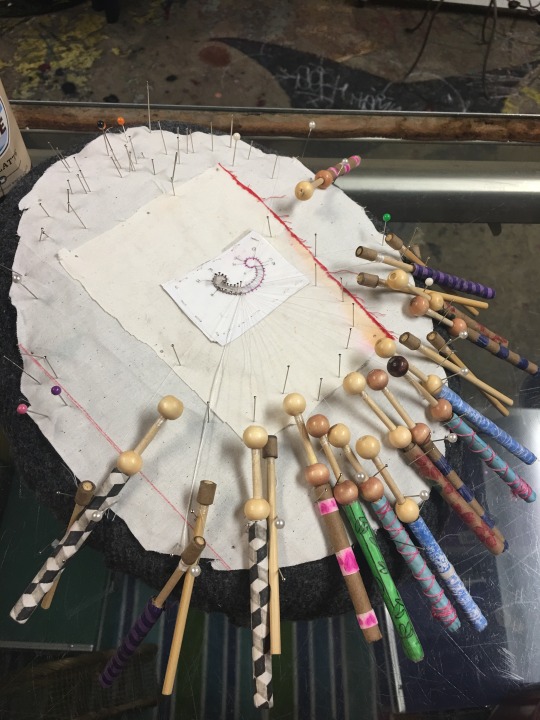

Tumblr won’t let me post more than ten photos to a post, so the pictures of the biggest piece of lace I made(and the one I’m most proud of), a Buckinghamshire Point edging will have to wait till tomorrow. All these pieces were made with Piper’s Silk floss. The next time I do any bobbin lace I want to get some cotton thread so my work will be less delicate, but it’s difficult to find cotton thread that is fine enough for my purposes, you pretty much have to get thread purpose-made for lacemaking, and it’s expensive.
21 notes
·
View notes
Text
Ingrid Seward and her Smear Campaign Against the Duchess of Sussex
The astonishing and unabating waves of vitriol and misogynoir directed against Meghan, Duchess of Sussex in the British tabloids are really something; yesterday Elton John took to Twitter to denounce “these relentless and untrue assassinations on their character that are spuriously crafted on an almost daily basis.” He was including Harry in his remarks, but the truth is that the vast majority of the press attacks are directed at Meghan.
They began when her engagement was announced, with such odious headlines as the Daily Mail’s “Harry’s Girl Is (Almost) Straight Outta Compton -- Gang-Scarred Home of Her Mother Revealed - So Will He Be Dropping By for Tea?” and they have never let up. (As it turns out, yes, the Duke and his mother-in-law visit frequently. She usually comes to them though, because they are a prince and a princess who live in a frickin’ castle--okay okay, on the grounds of a frickin’ castle--and can’t go anywhere without a paparazzi mob.)
Both the elegant and impressive Doria Ragland and her equally elegant and graceful daughter have borne the onslaught in silent dignity. It has been so ugly and unjust that the American press, and many in Hollywood, are now pushing back: Vanity Fair, The Washington Post, and Harper’s Bazaar, among other outlets, have published stories that all come to the obvious answer:

One interesting thing for Sussex fans, is that when you read the latest trash hit against Meghan, it’s often the same people saying the terrible things. Which then the other tabloids will pounce on and regurgitate and spin up into a fresh cycle of “controversy.”
Piers Morgan is perhaps the most obvious culprit. A lot of the Meghan-bashing stuff comes from that douchebag. But he at least has been appropriately challenged: Jameela Jamil accurately called him “a slut-shaming, fat-shaming, misogynist, irrelevant shit stain, smeared across our country.”
Friends, netizens, fellow blanket goblins. I am not here to talk about Piers Morgan. I am here to talk about someone that I don’t think has been named and shamed enough, because just as many of these ugly stories planted in the press turn out to come from her.
This is a callout post for Ingrid Seward.
Who is Ingrid Seward? She is a wretched fucking harpy, and also the editor in chief of Majesty magazine--which seems to be an online-only webzine with about the same production values as your local supermarket flyer? Anyway, nine times out of ten when a “royal expert” launches an attack on Meghan, it’s Ingrid Seward. Here’s a gallery of her greatest hits:
* Remember that whole business when Meghan came out after Archie’s birth for Trooping the Color, and people noticed she’d changed up the band of her engagement ring? At the time Ingrid Seward had a lot of sneering things to say about that, quotes that got picked up and cycled through a bunch of different outlets: “I find it a bit odd Meghan would want to alter a ring that her husband had especially designed for her...A royal engagement ring is a piece of history not a bit of jewelry to be updated when it looks old fashioned.” The implication of course here being that Meghan is not really one of us, she doesn’t understand the significance--Harry designed that ring with Diana’s stones, she’s desecrating it! (Never mind that it’s her damn ring, and that any alterations Meghan makes to her jewelry will simply add to the heritage and historicity of the pieces.) But it gets better!
* So then it came out that Harry had the band changed, actually, because he gave her a second ring when Archie was born and he wanted her to be able to wear them stacked. Was there any apology from Ingrid? No, of course not. She’d successfully planted one wave of bad stories about Meghan, and she’d moved on to the next wave--the christening.
* Right, remember all the kerfluffle around how Meghan and Harry wouldn’t allow press photographers at the christening? I’m not gonna say this one was entirely orchestrated by Ingrid, but man does it have her fingerprints all over it: she was very intentional about fanning up the flames of criticism, and very successful at it too. Here’s a quote from one representative bitchy piece in the Express: “Ingrid Seward, editor-in-chief of Majesty Magazine, said she felt that people were becoming a 'bit jaded' by 'stylised' pictures of the newest royal. 'I think what people want and what people are used to seeing are lovely family images of the baby in the royal Honiton lace christening gown. They won't want an arty Instagram shot of Archie's foot three days later if it's left up to the couple themselves to take pictures and release them,' she said, referring to a Mother's Day shot issued by the couple of their son on social media."
* She doesn’t name Meghan directly here, but it’s exactly the same implication as before--Meghan doesn’t understand the significance. Her Hollywood, Instagram, American style marks her as not one of us.
* And as usual once she’d successfully planted one negative quote somewhere, it would get picked up and amplified by other outlets. E! Online ran a piece that quoted her appearance on the Today show: "I've covered five or six christenings during my royal career and I've never come across such secrecy," Majesty magazine editor-in-chief Ingrid Seward said on Today.” The headline for the E! Online article was “The Archie Christening Controversy: Why Meghan Markle and Prince Harry Are Under Fire Yet Again.” Like yeah okay they are, but at some point don’t we get to talk about the fact that it’s always the same little squad doing the firing?
* Of course in the end what Meghan and Harry actually released were lovely family images of the baby in the royal Honiton lace christening gown, just like Ingrid Seward said she wanted.

* Was she happy?
* No. Her success at generating negative coverage for the Sussexes has only made her bolder. “I would think it might bother William a little bit, because he might see the way that Harry and Meghan do things as being detrimental to the business of the monarchy as a whole,” Ingrid Seward revealed in the British documentary titled ‘William & Harry: Princes At War?’ as reported by UK’s Daily Mail on Monday.”
* You can see how she gets the media machine to spin up and regurgitate and repackage her smears. That quote was actually from a Fox News piece: “Meghan Markle and Prince Harry’s ‘detrimental’ behavior ‘might bother’ Prince William, claims royal expert.”
* So one bad quote from Ingrid Seward generates negative TV and press coverage along many outlets. And she’s usually just referred to as a “royal expert,” which makes her fly under the radar more than Piers Morgan. But she is the news here! There’s no actual story about William: this entire news cycle of negative coverage is generated by Ingrid Seward, just like previous bad news cycles have been spun up by her.
* She never retracts her criticisms even when repeatedly proven incorrect (as with the ring and the christening photos), and other journos never stop quoting her, either.
* Here’s more from her: “And of course William and Kate would have quite naturally thought, ‘Oh, she’s been married before, she’s older than Harry, I hope she’s going to make him happy.’ Anyone would think that.” No, you fucking harpy, normal people just thought “what a lovely young couple!”
* I think it is honestly very reasonable to ask why the editor in chief of Majesty magazine appears to be orchestrating a smear campaign against the Duchess of Sussex. Isn’t she supposed to be a royal fan? Aren’t we all supposed to be celebrating the pretty dresses and the sparkly tiaras? Because that’s what I’m here for. But not Ingrid. Ingrid is here for something very calculated, and very ugly.
9 notes
·
View notes